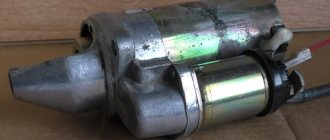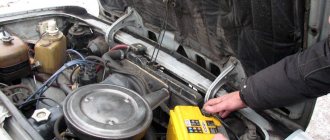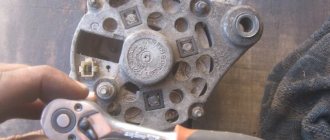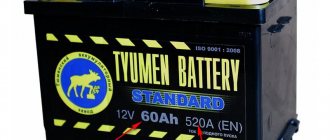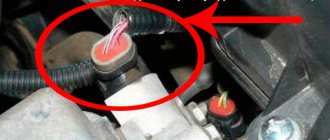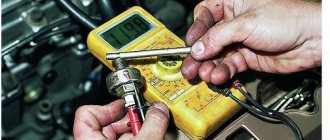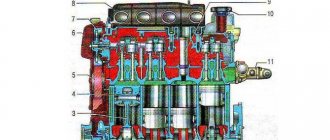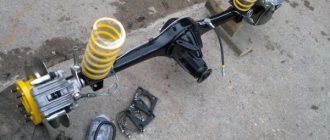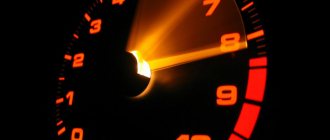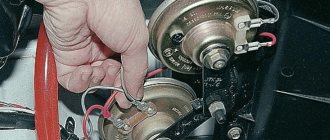Hello, dear car enthusiasts! Probably many of you, while driving your car, have been spoiled a lot by the Check Engine light that lights up, then goes out, or even burns (without any obvious reason) with an “eternal flame.”
What's wrong? Even many auto gurus cannot give an exact answer to the question why the injector light is on. Let's try to dig into the structural principle of the malfunction.
The electronic control unit (ECU) of your car controls the engine through a system of sensors. If the light comes on, this means that one or more sensor parameters have failed, to which the ECU reacts accordingly.
Let's consider the functions assigned to the injector sensors. Knowing what the sensors are responsible for, it is somewhat easier to judge the behavior of your car and draw conclusions: either fix the problem yourself, or contact a car service for it.
The injector light is on: what the sensors say
Crankshaft sensor - determines the speed of its rotation, position, and, consequently, the location of the pistons in the cylinder. The sensor operates based on electromagnetic induction.
If the injector is on because the crankshaft sensor is triggered, the consequences, if ignored, may be as follows: engine idling will be unstable, and if the sensor fails, the engine may stall and will not start at all.
The injector light is on for a reason, which is responsible for controlling the gas distribution control in each engine cylinder. In this case, the ECU switches from phase injection to backup - the so-called pair-parallel mode.
The operating principle of the sensor is based on the Hall effect; the sensor is located on the front of the block on the input manifold side. Typical signs of a malfunction are increased fuel consumption and hesitant engine starting.
If the injector icon is on due to the throttle sensor readings, then the characterizing factor of the malfunction is the specific ringing sound of engine detonation. The sound becomes most noticeable when the revs drop during acceleration. As a consequence of this: fuel consumption increases and power decreases, since the engine must constantly operate at low angles with ignition advance.
The injector indicator lights up due to the readings of the air sensor, which is responsible for assessing the air filling of the cylinders. Characteristic features of the malfunction, as a rule, are an increase in idle speed (1500-3000 rpm). Also, when you release the gas pedal, the speed decreases slowly or does not decrease at all without additional throttling. In addition, characteristic jerks are observed when accelerating the car.
If the injector light comes on due to the readings of the absolute pressure sensor, which reacts to its change in the intake tract, then the characterizing factor is the engine running on a too lean or rich combustible mixture. As a result, there will be an “incorrect” exhaust, misfire at idle, and problems will also arise when turning off the engine.
The injector indicator is on due to the temperature sensor readings, the purpose of which is to assess the thermal state of the engine. In this case, the ECU will select a backup mode, which involves turning on the cooling fan and driving the high idle speed. If the sensor fails, it becomes difficult to start the engine and increases fuel consumption.
Speed sensor - designed to estimate the speed of movement. If it does not work correctly, the motor will operate unstable, and if the load is suddenly dropped, the motor will stall. Deteriorated dynamics are also observed, and the trip computer and electronic speedometer give false readings.
Oxygen sensor - estimates the amount of oxygen in the exhaust gases. Characteristic factors in case of its malfunction are the appearance of periodic oscillations during idle mode and increased fuel consumption.
In addition to all of the above, the reasons may be mechanical damage to the circuit (break, short circuit), break or leakage of the gas distribution mechanism, moisture, overheating, etc.
If the injector is on, then the answer to the question “why?” will most accurately be answered by an error code that will determine the cause in a matter of seconds. Naturally, for this we need a motor tester or a specialized computer diagnostic program.
For many car enthusiasts, while driving, their mood is spoiled by the constantly burning or flashing Check Engine injector light. And there seem to be no obvious reasons for this. Even experienced car service technicians will not be able to give an answer to this right away. Let's try to understand in more detail the very structure of the mentioned reason.
The principle of operation is as follows: the vehicle's electronic control unit (ECU) controls its engine through sensors in the Powertrain system. When the injector light comes on, this means that one or more sensors indicate a change in parameters in a critical direction. Now let's look at some of the functions that are assigned to sensors, which will help you determine the nature of the violations.
Throttle Position Sensor
The sensor is responsible for the entire process of engine operation in acceleration, driving at a uniform speed and deceleration. The sensor is responsible for monitoring several engine modes, so it is extremely sensitive to the effects of electromagnetic fields and requires constant preventive maintenance, which can be carried out independently.
The sensor is usually located on the side of the engine and consists of two sensors, which are interconnected with the driver’s gas pedal through the computer. If the sensor is adjusted normally and the Check Engine lights up due to this reason, then it signals the owner about engine malfunctions. Indirect reasons may be: decreased power, increased fuel consumption, on cars with automatic transmission – characteristic “jerking” when switching gears, uncertain engine starting, “dips” during acceleration, increased idle speed. Ignoring this can result in serious engine damage, so you should immediately contact a car service center.
Mass Air Flow Sensor
The air sensor is responsible for filling the cylinders with air, thereby ensuring the optimal air/fuel mixture. Symptoms of a Check Engine fire, according to it, are an imbalance of air in the cylinders. As a rule, the idle speed increases (1500-3000 rpm), and when the pedal is released, the speed decreases slowly or does not decrease at all without additional throttling. As a result, there is a decrease in power due to oversaturation or, conversely, poor air saturation, characteristic “jerking” during acceleration.
Knock Sensor
If a car has a knock sensor, it is responsible for dampening strong engine vibration through dosed fuel supply, thereby ensuring fuel savings (about 9%).
In addition to the above, the reasons may be: open or short circuit, mechanical damage to the wiring, slippage or breakage of the gas distribution mechanism, external overheating, increased induction fields, moisture, etc.
If you are not confident in your abilities, do not under any circumstances start troubleshooting, seek the help of professionals, especially since today ECU diagnostics are inexpensive, and based on the readable error code, it allows you to accurately identify the faulty engine unit.
No amount of savings on repairs will help you if you face the risk of serious problems.
VAZs, like the vast majority of modern cars, have a lot of different sensors that monitor engine performance. Like other engines, the power unit of the latest VAZ models has an ECU (electronic control unit), which, if faults or disturbances in the operation of the internal combustion engine are detected, can issue an inscription that many motorists are very afraid of. As you understand, we are talking about Check Engine
, this is an error that means “check engine”, literally.
There is no need to despair over this error, as it can often indicate minor problems, such as bad fuel or the need to replace spark plugs. But unfortunately, there are situations when Check Engine can mean the “death” of the engine, so this error cannot be taken lightly, and at the first opportunity it is necessary to check all components that may be involved in the appearance of this error.
Check Engine sensors
" appeared in the 80s, they were invented to monitor the operation of the carburetor, so if the Check Engine light came on, it could only mean one thing - the carburetor was faulty. Over time, this “light bulb” was followed by other malfunctions that were already associated with malfunctions of the engine, as well as its various systems. Consequently, with the advent of new “responsibilities”, interpreting the appearance of the Check Engine has become quite difficult. The Check indicator lights up after the ECU detects problems with the engine. Various sensors report this to him, based on this the first conclusion can be drawn - the Check Engine can light up even if the sensors themselves malfunction.
It is normal for a Check Engine
after you turn the key in the ignition, after you start the engine, the inscription should disappear, if this does not happen, read about the reasons why this error may appear. When you start the engine, the ECU checks all systems and if there are no problems, the Check light goes out, but if the computer finds a breakdown, the light will not go out until you fix the problem or make an error.
Reasons for the appearance of Check Engine on VAZs
- The first reason, quite popular in our area, is bad gasoline. Often the check light comes on precisely because of poor fuel. This can be treated by draining the “bodyagi” and refueling with normal gasoline; if you feel sorry for gasoline, you can just wait until it runs out and refuel elsewhere with normal quality fuel.
- Candles. Damaged or faulty spark plugs can cause a Check Engine Light. For example, if the spark plug has an incorrect gap or the insulator is cracked. The solution is to check or .
- Low fuel level, gas tank cap not tightly closed. In both the first and second cases, a problem will arise with the pressure in the fuel system, after which the ECU will report the problem in the form of the appearance of a corresponding inscription.
- Problems with the ignition coil. The lack of a spark will lead to misfires in the cylinders, and the lambda probe will report an error to the control unit. The solution is and.
- Problems with the lambda probe itself (oxygen sensor). In this situation, repair is impossible; as a rule, there is only one way out -. You can, however, try, but it’s not a fact that it will lead to anything.
- Catalyst malfunctions. Most often, this breakdown occurs on cars with decent mileage. The catalyst is killed as a result of oil problems when the engine takes oil. The oil consumption does not go unnoticed; the remaining oil does not burn completely and is deposited on the catalyst honeycomb. Also, problems with the catalyst can arise due to poor fuel or due to mechanical damage to the catalyst. This problem can only be solved in one way - by complete replacement.
- Problem with injectors. The injectors may simply be clogged; the problem is solved by. If this does not help, the injectors will have to be replaced.
- There are malfunctions in the fuel system, the fuel pump is acting up, the fuel coarse filter or fuel filter is clogged. To confirm or refute this assumption, it is necessary to measure the pressure in the fuel rail and check the fuel pump.
- It happens that the Check Engine lights up due to problems with the BB wires. If there is a suspicion of their malfunction, it is necessary to check the high-voltage wires and, in case of malfunction, replace them.
- The mass air flow sensor (MAF) is often the reason why the “ Check Engine
” lights up. In order to find out if there is a problem with the sensor, you need. If it turns out that the sensor is faulty, replace it.
The engine is shaking, the check is flashing or on: the main causes of the malfunction
Experienced car mechanics and experts in the field of repair and diagnostics of faulty vehicles identify several reasons why the engine starts to stall and the check light comes on:
- Low quality fuel.
- No spark at the spark plugs.
- No spark at the ignition coil.
- The lambda probe does not work.
- Faulty catalyst.
- The injectors are clogged.
- Lack of required pressure in the rail due to a faulty fuel pump.
- High voltage wires are broken.
Most of the listed faults can be solved solely by transporting the car to a service center, followed by transferring it into the hands of an experienced technician. However, some of these problems can be solved independently, if you have the proper knowledge and skills. Read on to learn why the check engine light may blink and the engine stalls.
Engine tripping
Engine tripping is one of the malfunctions in the operation of the internal combustion engine, when one or more cylinders do not work partially or completely. This phenomenon is observed in the event of disturbances in the combustion process of the fuel-air mixture. The result of the malfunction is unstable operation of the engine, both at idle and under load or in transient modes. The list of main causes of engine tripping includes:
- supply of insufficient or excess fuel to the cylinders;
- supply of insufficient or excess air;
- presence of breakdowns recorded in the ignition system;
- wear or breakdown of the entire motor installation or its individual parts.
Simply put, engine tripping is observed in the event of breakdowns in the fuel system and injector, ignition system or intake air supply system.
Engine errors
A lit "check" indicates a danger to the catalysts. When connecting a faulty vehicle to a scanner, the technician will most likely receive a “p0300” error, indicating the presence of multiple misfires. There may be several reasons for this problem to occur:
- Burnt out valve.
- Faulty spark plugs.
- Presence of interturn short circuits in individual ignition coils.
- One or more injectors are not working.
Please note: an engine operating mode similar to tripping can be observed if the timing mark is incorrectly set.
Nuances in the operation of the Check Engine light
An illuminated Check Engine Light is an indicator that, when illuminated, indicates a variety of problems. However, even experienced technicians cannot always diagnose the corresponding faults without a lengthy and thoughtful examination.
In most cases, the blinking of the check light is associated with problematic combustion of the air mixture. A signal accompanied by engine vibration appears in the event of a cylinder malfunction. In addition, oxygen sensors can warn the driver that fuel is entering directly into the exhaust manifold, where it ignites under the influence of a critical temperature regime.
The check light came on after refueling
The Check Engine light may come on after refueling if:
- The seal of the fuel system was broken.
- The vehicle was filled with low-quality gasoline with a low octane number.
- Moisture getting inside the engine, with injection after washing, heavy rain or after crossing a river.
All of the above problems can be easily solved on the spot, without much effort or problems. The exception is if moisture gets inside the engine. If such a problem is suspected, the driver should remove excess water using a dry rag, and dry all components of the power unit using a hairdryer. If the check light comes on when you press the gas pedal, the problem does not lie in the quality of the fuel filled.
Is it possible to drive when the Check Engine light is on?
If you see that the Check Light has come on, the first thing you need to do is stop and listen, take a closer look at the operation of the engine. If everything is normal, the speed does not fluctuate, there are no noises, the fluid level (fuel, oil, coolant) is normal, you can continue driving, but upon arrival, be sure to visit a service station to determine the cause of the Check Engine. If the problem is resolved, then the Receipt sign should disappear soon, this can happen in an hour or in a day or two. If this does not happen, then the problem is not solved and the search for the fault must be resumed.
If you are unable to independently find the reason why this error occurs, contact a service station, where specialists, using special equipment, can easily determine the cause of the error and help eliminate it.
There is no need to despair over this error, as it can often indicate minor problems, such as bad fuel or the need to replace spark plugs. But unfortunately, there are situations when Check Engine can mean the “death” of the engine, so this error cannot be taken lightly, and at the first opportunity it is necessary to check all components that may be involved in the appearance of this error.
The first Check Engine sensors appeared in the 80s, they were invented to monitor the operation of the carburetor, so if the Check Engine light came on, it could only mean one thing - the carburetor was faulty. Over time, this “light bulb” was followed by other malfunctions that were already associated with malfunctions of the engine, as well as its various systems. Consequently, with the advent of new “responsibilities”, interpreting the appearance of the Check Engine has become quite difficult. The Check indicator lights up after the ECU detects problems with the engine. Various sensors report this to him, based on this the first conclusion can be drawn - the Check Engine can light up even if the sensors themselves malfunction.
It is considered normal for Check Engine to appear after you turn the key in the ignition; after you start the engine, the inscription should disappear; if this does not happen, read about the reasons why this error may appear. When you start the engine, the ECU checks all systems and if there are no problems, the Check light goes out, but if the computer finds a breakdown, the light will not go out until you fix the problem or make an error.
The check engine light is on - what should I do next?
You can try to find out the reason yourself by counting the number of blinks of the “check” and check the technical documentation for the designation of such an error code. For different cars there are different intervals between flashes and different codes by which they are interpreted.
Most of the errors that the indicator tells you about are not critical . You can perform diagnostics in two ways - yourself and by visiting a service station. The fact is that to obtain information in this case, you need special equipment or at least software for a smartphone.
But first of all, you need to find out how the car’s behavior changed after the error appeared. This is done in order to determine whether it is possible to drive with the check engine light on the panel, or whether it is better not to do this so as not to aggravate the problem.
Icon is lit continuously
No changes in car behavior
Movement is possible
continue
NOT continue driving
The car suddenly changed its behavior:
- The revolutions are floating;
- Engine vibration appeared;
- There is a burning smell;
- Other changes.
IT IS FORBIDDEN
keep moving
IT IS FORBIDDEN
keep moving
Engine power and throttle response remain the same
Can
keep moving
Can
keep moving
The engine has become less responsive, the speed does not rise above a certain value (engine operation in emergency mode)
You can continue moving
The movement cannot be continued
No additional warning lights came on on the instrument panel.
Along with the check engine icon, another indicator came on:
- Coolant light;
- Engine overheating;
- Oil lamp;
- Catalyst icon.
Movement is NOT allowed
continue
Movement is NOT allowed
continue
When does the check engine light come on?
We find out the reason why the check light is on
The error code can be read using a laptop with special software. The computer is connected via a cable to the machine's ECU and diagnostics are carried out. Also, using a laptop, you can enter additional external commands into the control unit or correct (reset) errors that appear.
A simpler method is to download an ECU communication and analytics program to your Android smartphone (for example, TORQUE, it has free and paid versions). And a Bluetooth adapter is connected to the electronic unit, which allows you to read information from the device. If you don’t have a laptop or you simply don’t want to bother installing additional software, you can delegate the described procedures to service station workers. They have all the necessary equipment and programs.
It must be remembered that each car (and sometimes each ECU on the same cars, but different years of manufacture) has a different list of error codes . Therefore, after receiving the information, you must have a standard set of diagnostic error codes (Diagnostic Trouble Code - DTC). You can find it in additional literature on diagnostics or on the Internet (for example, on thematic forums dedicated to your car model).
Another common cause for injection engines is problems with the injectors. In particular, the appearance of a significant amount of sediment on them. The solution to this problem is to clean the injectors. If problems occur with spark plugs, injectors, or the activated check engine indicator, the following symptoms may occur:
- weak engine thrust;
- high fuel consumption;
- jerks when accelerating or unstable operation of the engine;
- “floating” engine speed at idle.
The next step is to check the pressure in the fuel system. To do this you need to use a pressure gauge. The standard pressure for most non-tuned cars is 3 atmospheres (kgf/cm2). However, check this information in the registration certificate of your car. If the pressure is significantly lower, then the problem may lie in a faulty fuel pump or dirty injectors. If the pressure is constantly low, check the fuel pump. If at first it is normal, but drops shortly after starting the engine, check the injectors. Also pay attention to the mesh in the gas tank.
Reasons for the appearance of Check Engine on VAZs
- The first reason, quite popular in our area, is bad gasoline. Often the check light comes on precisely because of poor fuel. This can be treated by draining the “bodyagi” and refueling with normal gasoline; if you feel sorry for gasoline, you can just wait until it runs out and refuel elsewhere with normal quality fuel.
- Candles. Damaged or faulty spark plugs can cause a Check Engine Light. For example, if the spark plug has an incorrect gap or the insulator is cracked. The solution is to check or replace the spark plugs.
- Low fuel level, gas tank cap not tightly closed. In both the first and second cases, a problem will arise with the pressure in the fuel system, after which the ECU will report the problem in the form of the appearance of a corresponding inscription.
- Problems with the ignition coil. The lack of a spark will lead to misfires in the cylinders, and the lambda probe will report an error to the control unit. The solution is to check the ignition coil and replace it if it is faulty.
- Problems with the lambda probe itself (oxygen sensor). In this situation, repair is impossible; as a rule, there is only one way out - replacing the oxygen sensor. You can, however, try to clean the Lambda Probe, but it is not a fact that this will lead to anything.
- Catalyst malfunctions. Most often, this breakdown occurs on cars with decent mileage. The catalyst is killed as a result of oil problems when the engine takes oil. The oil consumption does not go unnoticed; the remaining oil does not burn completely and is deposited on the catalyst honeycomb. Also, problems with the catalyst can arise due to poor fuel or due to mechanical damage to the catalyst. This problem can only be solved in one way - by complete replacement.
- Problem with injectors. The injectors may simply be clogged; the problem can be solved by flushing the injectors. If this does not help, the injectors will have to be replaced.
- There are malfunctions in the fuel system, the fuel pump is acting up, the fuel coarse filter or fuel filter is clogged. To confirm or refute this assumption, it is necessary to measure the pressure in the fuel rail and check the fuel pump.
- It happens that the Check Engine lights up due to problems with the BB wires. If there is a suspicion of their malfunction, it is necessary to check the high-voltage wires and, in case of malfunction, replace them.
- The mass air flow sensor (MAF) is often the reason why the “Check Engine” lights up. In order to find out if there is a problem with the sensor, you need to check the mass air flow sensor. If it turns out that the sensor is faulty, replace it.
Why does the check light up? The most common and common malfunctions
So, we figured out the general scheme.
Now let's look at what problems lead to the check light coming on and the engine stalling. Often a p0300 error occurs, which indicates that a misfire (misfire) is occurring. There are several reasons for these omissions, and to determine them it is necessary to carry out a step-by-step diagnosis, taking into account certain individual symptoms. You should start by checking the ignition system. The most common cause of tripping is the failure of spark plugs and armored wires. Candles can wear out their service life, break down, or become heavily contaminated. Armored wires suffer from insulation damage and breakdowns. One way or another, the result is either no spark at all, or there is a spark, but it’s weak.
If everything is in order with the spark plugs and wires, you should pay attention to the ignition module or ignition coils, which may be shorting. In this case, it is better to entrust the check to experienced specialists, since unprofessional actions lead to the fact that you can burn the switch or damage other important elements
It should also be added that you need to carefully inspect the spark plug wells themselves. Quite often, the engine fails if water accumulates in the wells or engine oil gets there. In some cases, lubricant gets into the wells due to problems with the valve cover gasket.
Having dealt with the ignition system, it is necessary to check the power system. As a rule, incorrect operation of injection nozzles or malfunctions in their operation lead to engine tripping. At the same time, the check will light up or flash.
We also recommend reading the article about what misfires in engine cylinders are. In this article, you will learn about the causes of misfires and errors, as well as how to identify and fix the problem.
The best option would be to check the injectors on a special stand. Such diagnostics allows you to determine the need to clean, repair or replace injectors. At the same time, specialists check the power supply to the injectors, the condition of the injector O-rings, etc.
As for compression, a burnt-out valve often leads to an unexpected decrease in the indicator. If the valve burns out, the engine starts to run rough. In this case, tripling is constant and occurs in all modes of engine operation. Engine thrust drops significantly, and significant excess fuel consumption is observed.
Please note that in this case you cannot drive the car, as there is a high risk of damaging the catalyst and oxygen sensor (lybda probe). To confirm the diagnosis, you need to measure the compression, and to solve the problem itself, you need to remove the cylinder head, troubleshoot the head and change the valve.
Is it possible to drive when the Check Engine light is on?
If you see that the Check Light has come on, the first thing you need to do is stop and listen, take a closer look at the operation of the engine. If everything is normal, the speed does not fluctuate, there are no noises, the fluid level (fuel, oil, coolant) is normal, you can continue driving, but upon arrival, be sure to visit a service station to determine the cause of the Check Engine. If the problem is resolved, then the Receipt sign should disappear soon, this can happen in an hour or in a day or two. If this does not happen, then the problem is not solved and the search for the fault must be resumed.
Auto electrician website. Repair practice, electrical circuits, etc.
So, you have purchased a good, unpretentious car - a VAZ. But at one fine moment, the “Check Engine” icon lit up on the dashboard of your car, the literal translation is “check the engine”, in the slang of auto mechanics - “throw out the engine”, “meat grinder”, “check”, etc. (applies only to injection cars - Priors, Kalinas, etc.) The “check engine” icon itself, which does not go out after starting the engine, indicates a malfunction or electrical malfunction in the electronic engine control system (ECM). Many irresponsible citizens believe that in a domestic car the “check” should always be on, but this is not true; in a working car, no yellow or red indicators on the instrument panel should be on.
What malfunctions of the engine control system light the check?
A malfunction of the air flow meter MAF (mass air flow sensor) can light up the check lamp, errors P0102 or P0102, and a faulty flow meter also leads to such troubles as uneven engine operation, lack of acceleration dynamics, and high fuel consumption. As the name suggests, this sensor measures the amount of air entering the engine intake manifold and, based on this data, the control unit calculates the required amount of fuel. In general, this is the most important sensor in the engine control system; a lot depends on its readings. The air flow meter can either completely fail or distort the readings, which will lead to improper engine operation. A malfunction of the mass air flow sensor cannot always be easily diagnosed; the easiest way to diagnose it is to replace it with a known good one, taken from a neighbor. Connection diagram for VAZ mass air flow sensor.
A faulty intake air temperature sensor (built into the mass air flow sensor) causes errors P0112 or P0113. The air temperature sensor readings are used by the control unit to adjust the fuel mixture depending on the outside air temperature. The temperature sensor cannot be replaced separately from the air flow meter.
Malfunction of oxygen sensors , both front (before the catalyst) and rear (after the catalyst). Malfunctions of oxygen sensors can be different, such as an open heating circuit (easily diagnosed with a multimeter), or such malfunctions as a slow response of the sensor due to aging or poisoning with low-quality fuel, which often do not cause the check to ignite, greatly affecting fuel consumption, vehicle dynamics, difficult to diagnose.
A malfunction of the catalyst “low catalyst efficiency” lights up the “check” lamp and has a slight, practically no effect on the behavior of the car. What is a catalyst and why is it needed?
A malfunction of the coolant temperature sensor causes the check ignition and errors P0117 or P0118, depending on whether it is a break or short circuit in the sensor or its wiring. It can be easily diagnosed with a multimeter; the repair manual gives the reference resistances of the sensor at different temperatures.
A malfunction of the throttle position sensor will lead to errors P0122, P0123 and emergency operation of the engine; the serviceability of the throttle position sensor is checked with a multimeter.
Lean mixture - error P0171 has many possible causes, first of all, low fuel pressure and further possible causes are clogged fuel injectors, air leaks, a malfunction of the air flow meter, a malfunction of the ignition system. We consistently diagnose all these reasons. For example, in this case the fuel pump turned out to be faulty.
Rich mixture - error P0172 may be due to a malfunction of the fuel pressure regulator (high pressure in the fuel system) we check by measuring the fuel pressure, leaking fuel injectors, faulty air flow meter, faulty oxygen sensor, stuck canister purge valve, problems with engine mechanics.
Broken fuel injector - errors P0201, P0202, P0203, P0204, the last digit is the number of the cylinder with the malfunction, the faulty cylinder does not work.
Fuel pump circuit malfunction - error P0230, this error indicates a break not in the fuel pump, but in the primary circuit of the fuel pump relay, most often the cause is an alarm lock or anti-theft lock.
Misfires - errors P0300, p0301, P0302, P0303, P0304. It is more correct to say misfires; using the crankshaft position sensor, the engine control unit measures the angular acceleration of each cylinder; if acceleration does not occur in this cylinder, “the counter is triggered,” when the counter overflows, the check light comes on or starts flashing with the corresponding errors. The most common cause is a malfunction of the ignition system - here the ignition coil turned out to be faulty.
A faulty knock sensor lights up the check with errors P0326, P0327, P0328. If the knock sensor malfunctions, the control unit goes into emergency operation mode and sets a safe (late) ignition timing angle. Affects dynamics and fuel consumption.
Crankshaft position sensor malfunction - error P0335. We check the crankshaft position sensor with an oscilloscope. In this case, the sensor stopped working after the engine warmed up.
Malfunction of the camshaft position sensor - error P0340, checked in the same way as the crankshaft position sensor.
P0500 - a malfunction of the vehicle speed sensor leads to decreased dynamics and increased fuel consumption.
Malfunction of the canister purge valve - error P0443, does not affect engine operation unless it is stuck open. The car's fuel tank is sealed, fuel vapors are collected in the canister and, when the engine is running, through the canister valve they enter the engine intake manifold, where they burn together with the working mixture.
Well, electrical wiring faults happen in these beautiful, moderately reliable cars; they manifest themselves in different ways, such as blown fuses due to a wire from the oxygen sensor stuck to the exhaust pipe, or torn wires from the crankshaft sensor, etc.
Why does the check light on the VAZ light up?
So, you have purchased a good, unpretentious car - a VAZ. But at one fine moment, the “Check Engine” icon lit up on the dashboard of your car, the literal translation is “check the engine”, in the slang of auto mechanics - “throw out the engine”, “meat grinder”, “check”, etc. (applies only to injection cars - Priors, Kalinas, etc.) The “check engine” icon itself, which does not go out after starting the engine, indicates a malfunction or electrical malfunction in the electronic engine control system (ECM). Many irresponsible citizens believe that in a domestic car the “check” should always be on, but this is not true; in a working car, no yellow or red indicators on the instrument panel should be on.
What malfunctions of the engine control system light the check?
A malfunction of the air flow meter MAF (mass air flow sensor) can light up the check lamp, errors P0102 or P0102, and a faulty flow meter also leads to such troubles as uneven engine operation, lack of acceleration dynamics, and high fuel consumption. As the name suggests, this sensor measures the amount of air entering the engine intake manifold and, based on this data, the control unit calculates the required amount of fuel. In general, this is the most important sensor in the engine control system; a lot depends on its readings. The air flow meter can either completely fail or distort the readings, which will lead to improper engine operation. A malfunction of the mass air flow sensor cannot always be easily diagnosed; the easiest way to diagnose it is to replace it with a known good one, taken from a neighbor. Connection diagram for VAZ mass air flow sensor.
A faulty intake air temperature sensor (built into the mass air flow sensor) causes errors P0112 or P0113. The air temperature sensor readings are used by the control unit to adjust the fuel mixture depending on the outside air temperature. The temperature sensor cannot be replaced separately from the air flow meter.
Malfunction of oxygen sensors, both front (before the catalyst) and rear (after the catalyst). Malfunctions of oxygen sensors can be different, such as an open heating circuit (easily diagnosed with a multimeter), or such malfunctions as a slow response of the sensor due to aging or poisoning with low-quality fuel, which often do not cause the check to ignite, greatly affecting fuel consumption, vehicle dynamics, difficult to diagnose.
A malfunction of the catalyst “low catalyst efficiency” lights up the “check” lamp and has a slight, practically no effect on the behavior of the car. What is a catalyst and why is it needed?
A malfunction of the coolant temperature sensor causes the check ignition and errors P0117 or P0118, depending on whether it is a break or short circuit in the sensor or its wiring. It can be easily diagnosed with a multimeter; the repair manual gives the reference resistances of the sensor at different temperatures.
A malfunction of the throttle position sensor will lead to errors P0122, P0123 and emergency operation of the engine; the serviceability of the throttle position sensor is checked with a multimeter.
Lean mixture - error P0171 has many possible causes, first of all, low fuel pressure and further possible causes are clogged fuel injectors, air leaks, a malfunction of the air flow meter, a malfunction of the ignition system. We consistently diagnose all these reasons. For example, in this case the fuel pump turned out to be faulty.
Rich mixture - error P0172 may be due to a malfunction of the fuel pressure regulator (high pressure in the fuel system) we check by measuring the fuel pressure, leaking fuel injectors, faulty air flow meter, faulty oxygen sensor, stuck canister purge valve, problems with engine mechanics.
Broken fuel injector - errors P0201, P0202, P0203, P0204, the last digit is the number of the cylinder with the malfunction, the faulty cylinder does not work.
Fuel pump circuit malfunction - error P0230, this error indicates a break not in the fuel pump, but in the primary circuit of the fuel pump relay, most often the cause is an alarm lock or anti-theft lock.
Misfires - errors P0300, p0301, P0302, P0303, P0304. It is more correct to say misfires; using the crankshaft position sensor, the engine control unit measures the angular acceleration of each cylinder; if acceleration does not occur in this cylinder, “the counter is triggered,” when the counter overflows, the check light comes on or starts flashing with the corresponding errors. The most common cause is a malfunction of the ignition system - here the ignition coil turned out to be faulty.
Checking the ignition coil
A faulty knock sensor lights up the check with errors P0326, P0327, P0328. If the knock sensor malfunctions, the control unit goes into emergency operation mode and sets a safe (late) ignition timing angle. Affects dynamics and fuel consumption.
Crankshaft position sensor malfunction - error P0335. We check the crankshaft position sensor with an oscilloscope. In this case, the sensor stopped working after the engine warmed up.
Malfunction of the camshaft position sensor - error P0340, checked in the same way as the crankshaft position sensor.
P0500 - a malfunction of the vehicle speed sensor leads to decreased dynamics and increased fuel consumption.
Malfunction of the canister purge valve - error P0443, does not affect engine operation unless it is stuck open. The car's fuel tank is sealed, fuel vapors are collected in the canister and, when the engine is running, through the canister valve they enter the engine intake manifold, where they burn together with the working mixture.
Well, electrical wiring faults happen in these beautiful, moderately reliable cars; they manifest themselves in different ways, such as blown fuses due to a wire from the oxygen sensor stuck to the exhaust pipe, or torn wires from the crankshaft sensor, etc.
